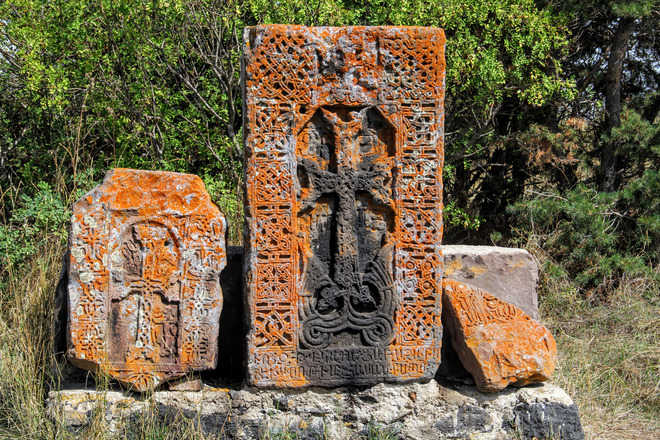Kalpana Sunder
I am in love… with intricate patterns of leaves, grapes and pomegranates, rosettes and saints carved on stone. I am looking at Armenia cross stones with burnished orange lichen, called “khachkars” — a word formed by two Armenian roots: “khach” (cross) and “kar” (stone). The cross is the most familiar symbol of Christianity, and in Armenia, this iconography is entrenched in its culture.
Wherever you go, thousands of khachkars, or cross-stones, pervade the world’s oldest Christian nation, providing a rare glimpse into spiritual expression. “Christianity is at the very core our national identity”, explains guide Tatevik.
In 301, King Tiridates III, who had previously persecuted Christians and imprisoned St Gregory, the illuminator, for 12 years, finally repented. He was baptised by Gregory, and declared Christianity the new state religion.
Since 2010, khachkars, their symbolism and craftsmanship are inscribed in the UNESCO list of Intangible Cultural Heritage.
The khachkar bears resemblance to other forms of Christian art, like the Celtic High Cross. This stone stele features a variety of floral, vegetative, and geometric motifs, as well as tableaus of famous biblical scenes. How this medieval stone did become so charged with the Armenian spirit? The resurrection of Jesus, however, and the persecution of the early Armenian Christians transformed the cross into an emblem of triumph. At the same time, the mountain, as a biblical location, connoted austerity, reverence, and closeness with God. For early Armenians, mountain worship evolved into a stone stela that could be conveniently erected near the home or church. The khachkar was seen as also a mediator between the Christian and the pagan, the secular and the divine. It served various functions from a gravestone, talisman, to a commemorative shrine of events.
Khachkars originated in the beginning of the 4th century right after the adoption of Christianity. Since wood was not durable, these were replaced by stone ones. The peak of the khachkar carving art was between the 12th and the 14th centuries. The art declined during the Mongol invasion at the end of the 14th century.
Armenia, with its vast mountain ranges and dormant volcanoes, has no trouble sourcing the slate and tuff stone needed to make khachkars. The central symbol of any khachkar is a growing tree or a flower, cross— the symbol of new eternal life. Under the cross is a circle with the cross on it — that symbolises celebration of Christian faith. Above the cross, they usually placed common Christian faiths symbols of four evangelists — an eagle, a lion, a bull and an angel.
Khachkars were commissioned for a number of social, spiritual, or individual reasons — some were dedicated to saints. At Sevenavank Monastery, along the azure Lake Sevan, Tatevik shows us a very unique khachkar in which the anonymous artist, defying conventional composition, shows a Christ figure with Mongol features — slanted eyes, a beard, and long braided hair. “This was a ploy to protect its destructions from Mongol invaders,” she explains.
Using nothing but chisels and hammers, local craftsmen still continue to fashion out intricate designs in stone. Modern khachkars continue to feature ancient symbols and motifs such as the sun. Designs are carved using chisel, die, sharp pens and hammers. The carvings are then ground using fine sand. Khachkars also depict saints and biblical imagery such as the dove and the grapevine. No two khachkars are ever alike, adding to their unique character. Connecting the past and the present, the unique art form of khachkar continues to watch over the world’s oldest Christian nation.
Unlock Exclusive Insights with The Tribune Premium
Take your experience further with Premium access.
Thought-provoking Opinions, Expert Analysis, In-depth Insights and other Member Only Benefits
Already a Member? Sign In Now










